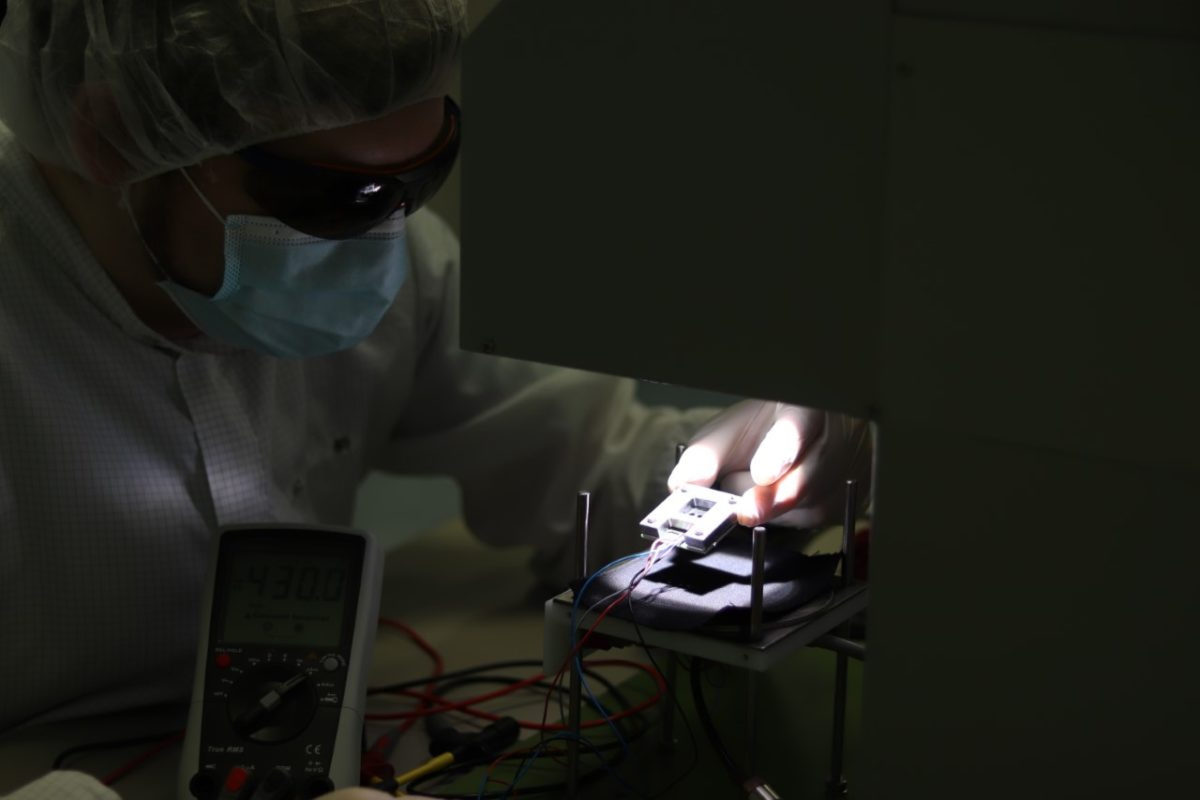A group of scientists from the University of Wuppertal in Germany has developed a perovskite-organic tandem solar cell with optimized charge extraction, a high open-circuit voltage, and a thickness of just 1 µm.
“Our solar cells are basically the weight of the substrate we are processing them on and can be processed on almost any smooth substrate that one could think of – from the roof of cars over building facades, backsides of mobile phones, to plastic foils or could even be integrated into clothes,” researcher Kai Brinkmann told pv magazine.
The tandem configuration includes a narrow-bandgap organic subcell with a p-i-n-type architecture based on the polymer PM6 and molybdenum oxide (MoOx) as the hole extraction layer (HEL). The cell has a power conversion efficiency of 17.5%, an open-circuit voltage of 0.87 V, a short-circuit current of 26.7 mA cm−², and a fill factor of 75%. The wide-bandgap perovskite subcell was built with a perovskite known as FA0.8Cs0.2Pb(I0.5Br0.5)3, with an efficiency of 16.8%, an open-circuit voltage of 1.34 V, a short-circuit current of 15.6 mA cm−², and a fill factor of 81%.
The scientists tried to reduce interfacial losses between the two cells, which are responsible for limiting the open-circuit voltage in tandem devices. They used an interconnect based on a 1.5 nm ultra-thin metal-like indium oxide layer grown via atomic deposition layer with unprecedented low optical and electrical losses.
“We leveraged the unique property of ALD to provide utmost control of layer thickness even at the level of ångströms, which is impossible with conventional deposition techniques,” they said.
The ultra-thin interconnect is claimed not to introduce notable optical losses and to boost the external quantum efficiency (EQE) of the organic back-cell and the overall short-circuit current of the tandem device by about 1.5 mA cm −2 compared to a reference cell with an interconnect based on 1 nm of silver, which results in an efficiency of only about 20%.
By contrast, the tandem solar cell achieved a power conversion efficiency of 24.0%, an open-circuit voltage of 2.15 V, a short-circuit current of 14.0 mA cm−², and a fill factor of 80%.
“The high EQE values (>95%) in the wavelength region between 400 nm and 500 nm can be explained by optical effects associated with the high refractive index of the perovskite material, which affords an efficient in-coupling of light into the active medium in this spectral range,” the research group said. “The high open-circuit voltage of 2.15 V of the tandem cell results from an almost ideal addition of the J-V characteristics of the subcells without any loss in open-circuit voltage.”
They described the solar cell in “Perovskite–organic tandem solar cells with indium oxide interconnect,” which was recently published in Nature. Fraunhofer ISE CalLab certified an efficiency of 23.1%, according to the IEC 60904-3 procedure.
“At the time we started this project, perovskite/organic tandems were just around 20% efficient. We are now at 24% and simulations show that our concept should allow us to reach efficiencies even beyond 30%,” Brinkmann concluded.
This content is protected by copyright and may not be reused. If you want to cooperate with us and would like to reuse some of our content, please contact: editors@pv-magazine.com.




3 comments
By submitting this form you agree to pv magazine using your data for the purposes of publishing your comment.
Your personal data will only be disclosed or otherwise transmitted to third parties for the purposes of spam filtering or if this is necessary for technical maintenance of the website. Any other transfer to third parties will not take place unless this is justified on the basis of applicable data protection regulations or if pv magazine is legally obliged to do so.
You may revoke this consent at any time with effect for the future, in which case your personal data will be deleted immediately. Otherwise, your data will be deleted if pv magazine has processed your request or the purpose of data storage is fulfilled.
Further information on data privacy can be found in our Data Protection Policy.